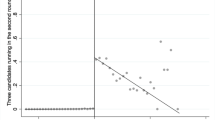Abstract
From 1939 to 1968 Florida used a unique referendum system to set property tax rates for public school operating expenditures at the median millage rate selected by voters. These referendums revealed the entire distribution of voter preferences, which is not possible in the standard up or down referendum. We are the first to use the Florida referendum data. The form of the ballot played an important role in how people voted. Voting machine elections were much more likely than paper ballots to result in rejections of the recommendations of school boards, and produced much greater dispersion of expressed preferences.
Similar content being viewed by others
References
Bergstrom, T.C., Rubinfeld, D.L., & Shapiro, P. (1982). Micro-based estimates of demand functions for local school expenditures. Econometrica, 50(5), 1183–1206.
Black, D. (1958). The Theory of Committees and Elections. Cambridge: Cambridge University Press.
Bowen, H.R. (1943). The interpretation of voting in the allocation of economic resources. Quarterly Journal of Economics, 58, 27–48.
Brennan, G., & Lomasky, L. (1993). Democracy and Decision: The Pure Theory of Electoral Preference. Cambridge: Cambridge University Press.
Cameron, A.C., & Trivedi, P.K. (2005). Microeconometrics: Methods and Applications. Cambridge: Cambridge University Press.
Clarke, E.H. (1971). Multipart pricing of public goods. Public Choice, 11, 17–33.
DeCanio, S.J. (1980). Economic losses from forecast error in agriculture. Journal of Political Economy, 88, 234–258.
Downs, A. (1957). An Economic Theory of Democracy. New York: Harper & Row.
Fiorina, M.P. (1976). The voting decision: Instrumental and expressive aspects. Journal of Politics, 38, 390–415.
Hamilton, J.T., & Ladd, H.F. (1996). Biased ballots? The impact of ballot structure on North Carolina elections in 1992. Public Choice, 87, 259–280.
Holcombe, R.G. (1977). The Florida system: A Bowen equilibrium referendum process. National Tax Journal, 30, 77–84.
Holcombe, R.G. (1980). An empirical test of the median voter model. Economic Inquiry, 18, 260–274.
Holcombe, R.G. (1989). The median voter model in public choice theory. Public Choice, 61, 115–125.
Hotelling, H. (1929). Stability in competition. Economic Journal, 39, 41–57.
Husted, T.A., Kenny, L.W., & Morton, R.B. (1995). Constituent errors in assessing their senators. Public Choice, 83, 251–271.
Kahneman, D. (2003). Maps of bounded rationality: Psychology for behavioral economics. American Economic Review, 93, 1449–1475.
Lott, J.R. Jr. (2003). Nonvoted ballots and discrimination in Florida. Journal of Legal Studies, 32, 181–220.
Lott, J.R. Jr. (2004). Non-voted ballots, Voter Fatigue, and Race. Working paper.
Lupia, A. (1994). Shortcuts versus encyclopedias: Information and voting behavior in California insurance reform elections. American Political Science Review, 88, 63–76.
McKelvey, R.D. (1976). Intransitivities in multi dimensional voting models and some implications for agenda control. Journal of Economic Theory, 12, 472–482.
Mueller, D.C. (2003). Public Choice III. Cambridge: Cambridge University Press.
Munley, V.G. (1982). An alternative test of the Tiebout hypothesis. Public Choice, 38, 211–217.
Munley, V.G. (1984). Has the median voter found a ballot box that he can control? Economic Inquiry, 22, 323–336.
Nechyba, T.J. (1990). The southern wage gap, human capital, and the quality of education. Southern Economic Journal, 57, 308–322.
Romer, T., & Rosenthal, H. (1978). Political resource allocation, controlled agendas, and the status quo. Public Choice, 33, 27–43.
Schmidt, A.B., Kenny, L.W., & Morton, R.B. (1996). Evidence on electoral accountability in the U.S. senate: Are unfaithful agents really punished? Economic Inquiry, 34, 545–567.
Schultz, T.W. (1975). The value of the ability to deal with disequilibria. Journal of Economic Literature, 13, 827–846.
Stata. (2001). Stata Reference Manual Release 7, Volume 2 H-P. College Station, Texas: State Press.
Thomas, N.C. (1968). Voting machines and voter participation in four Michigan constitutional revision referenda. Western Political Quarterly, 21, 409–419.
Tideman, T.N., & Tullock, G. (1976). A new and superior process for making social choices. Journal of Political Economy, 84, 1145–1160.
Author information
Authors and Affiliations
Corresponding author
Rights and permissions
About this article
Cite this article
Holcombe, R.G., Kenny, L.W. Evidence on voter preferences from unrestricted choice referendums. Public Choice 131, 197–215 (2007). https://doi.org/10.1007/s11127-006-9113-1
Received:
Accepted:
Published:
Issue Date:
DOI: https://doi.org/10.1007/s11127-006-9113-1




